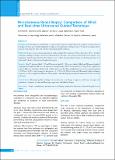Please use this identifier to cite or link to this item:
https://hdl.handle.net/20.500.14356/1602Full metadata record
| DC Field | Value | Language |
|---|---|---|
| dc.contributor.author | Pokhrel, Anil | - |
| dc.contributor.author | Agrawal, Rajendra Kumar | - |
| dc.contributor.author | Baral, Anil | - |
| dc.contributor.author | Rajbhandari, Ajaya | - |
| dc.contributor.author | Hada, Rajani | - |
| dc.date.accessioned | 2023-05-16T08:11:06Z | - |
| dc.date.available | 2023-05-16T08:11:06Z | - |
| dc.date.issued | 2018 | - |
| dc.identifier.citation | PokhrelA., AgrawalR. K., BaralA., RajbhandariA., & HadaR. (2018). Percutaneous Renal Biopsy: Comparison of Blind and Real-time Ultrasound Guided Technique. Journal of Nepal Health Research Council, 16(1), 66-72. https://doi.org/10.33314/jnhrc.v16i1.988 | en_US |
| dc.identifier.issn | Print ISSN: 1727-5482; Online ISSN: 1999-6217 | - |
| dc.identifier.uri | http://103.69.126.140:8080/handle/20.500.14356/1602 | - |
| dc.description | Original Article | en_US |
| dc.description.abstract | Abstract Background: Percutaneous renal biopsy is performed for diagnosis and prediction of prognosis of renal diseases. Adequacy of tissue and clinically significant bleeding are the main issues of the procedure. We aimed to compare these issues in renal biopsy by blind and real time ultrasound guided technique. Methods: It was a cross sectional, randomized study conducted between June 2016 to December 2016. In blind technique, marking for biopsy was done by ultrasound. Two attempts were performed for all and more if tissue was inadequate. Patients kept in bed rest for 24 hours, observed for post procedure hematuria and ultrasound done at 6 hours and 24 hours to diagnose perinephric hematoma. Results: Total 75 biopsies (blind = 37 and Ultrasound -guided = 38) were evaluated. Blind and Ultrasound-guided technique had significant difference of number of attempt (mean±SD) 2.4±0.6 and 2.1±0.3 (p<0.01) respectively with no difference of number of glomeruli in light microscopy. Bleeding complications were macroscopic hematuria (11(30%)vs15(40%)) and perinephric hematoma ( 5(13.5%)vs3(7.9%)) in blind and Ultrasound-guided technique respectively with no significant difference. Those patients who developed perinephric hematoma was observed in all at 6 hours. Conclusions: Ultrasound-guided technique of percutaneous renal biopsy is superior with fewer attempts and equivalent in adequacy of tissue and bleeding complication than blind technique. Keywords: Biopsy complications; percutaneous renal biopsy; perinephric hematoma; ultrasound-guided renal biopsy. | en_US |
| dc.language.iso | en_US | en_US |
| dc.publisher | Nepal Health Research Council | en_US |
| dc.relation.ispartofseries | Jan - Mar 2018;988 | - |
| dc.subject | Biopsy complications | en_US |
| dc.subject | Percutaneous renal biopsy | en_US |
| dc.subject | Perinephric hematoma | en_US |
| dc.subject | Ultrasound-guided renal biopsy | en_US |
| dc.title | Percutaneous Renal Biopsy: Comparison of Blind and Real-time Ultrasound Guided Technique | en_US |
| dc.type | Journal Article | en_US |
| local.journal.category | Original Article | - |
| Appears in Collections: | Vol. 16 No. 1 Issue 38 Jan-Mar 2018 | |
Files in This Item:
| File | Description | Size | Format | |
|---|---|---|---|---|
| 988-Manuscript-3922-2-10-20180314.pdf | Full text Article | 349.12 kB | Adobe PDF |  View/Open |
Items in DSpace are protected by copyright, with all rights reserved, unless otherwise indicated.
